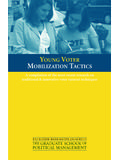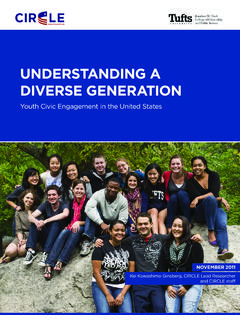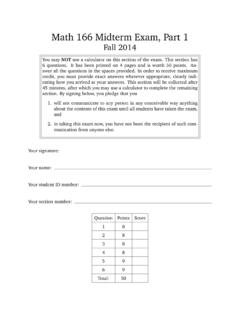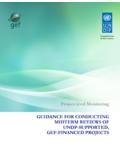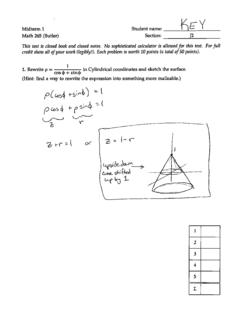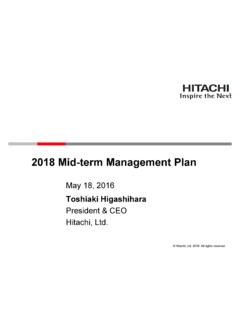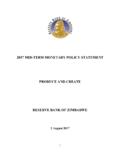Transcription of Voter Registration among Young People in …
1 Voter Registration among Young People in midterm Elections By: Kei Kawashima-Ginsberg 1 June, 2014 This brief summarizes historical trends and analysis about why and how Young People register to vote, and why they do not. The fact sheet focuses on midterm elections, especially the 2010 contest, which is the most comparable election to the upcoming 2014 midterm . In this brief, the terms Young People and youth refer to citizens ages 18-29. State-specific historical data on this demographic group s voting and Registration rates are available here. Youth Registration Rates among the Lowest in Recent Years Similar to older age groups, youth Voter turnout and Registration rates during midterm years are far lower than during presidential election years.
2 There are many reasons, including differences in media coverage, the competitiveness of elections, and the intensity of Voter outreach efforts. The drop in youth Registration rates between a presidential election and the subsequent midterm election ranges from seven to 12 percentage points. Within elections of the same type ( presidential or midterm ), youth Registration rates have been relatively low recently compared to earlier contests. The Registration rates were 49% in 2010 and 58% in 2012 (s ee Table 1). Table 1 Historical Voter Registration Rates among 18 to29-year-old Citizens, by Type of Election Presidential Election Years Voter Registration Rates among 18 to 29-year-old Citizens midterm Election Years Voter Registration Rates among 18 to 29-year-old Citizens 1972* 64% 1974* 48% 1976* 58% 1978 48% 1980 58% 1982 50% 1984 60% 1986 51% 1988 56% 1990 49% 1992 62% 1994 50% 1996 62% 1998 55% 2000 55% 2002 56% 2004 60% 2006 51% 2008 61% 2010 49% 2012 58% Source: Author s tabulations from the Current Population Survey, November (Voting) Supplement, 1972-2012.
3 *1972-1976 Registration rates are computed for residents due to data availability. Barriers to Registration Vary by Age and State Laws The Registration process can be confusing to Young People . In fact, they are more likely than older citizens to name lack of knowledge and technical barriers as the main reasons for not registering to vote. For example, a combined 24% of youth said that they missed the Registration deadline or that they did not know how or where to register. On the other hand, only a combined 14% of adults 30-or-older named one of those two as the main reason for not registering. By contrast, there was no notable difference between younger and older People in the proportion of citizens who cited a lack of interest as their main reason for not registering (Figure 1).
4 2 Starting around 2011, legislators across the country passed an increasing number of laws that restrict who, when, and where voters can get At the same time, more states allowed Same Day Registration (SDR) in 2012 than in past elections. Our analysis of 2012 voting data suggests that Young People are likely to be affected by both of these policies. The aggregated Registration rate of youth living in the states with Registration restrictions was six percentage points lower than the aggregated Registration rate of those who lived in states without such barriers (Figure 2). On the other hand, the aggregated Registration rate of Young People living in the SDR states was six percentage points higher than the Registration rate among youth living in non-SDR states (Figure 3).
5 3 17% 7% 5% 2% 1% 45% 3% 6% 14% 10% 4% 4% 6% 2% 47% 4% 6% 16% 0%10%20%30%40%50%Did not meet Registration deadlineDid not know where or howDid not meet residencyPermanent illness or disabilityDifficulty with EnglishNot interestedMy vote would not make a differenceNot eligible to voteOther reasonFigure 1: Main Reason for Not Registering, by Age (2010) Age 18-29 Age 30 and olderSource: Author's analysis of the CPS November Registration and Voting data, 2010 59% 75% 53% 75% 0%20%40%60%80%Age 18-29 Age 30 and olderFigure 2: Registration Rates (2012) by Presence of Restriction on Registration and Age No restrictionRestriction in effect63% 81% 57% 75% 0%50%100%Age 18-29 Age 30 and olderFigure 3: Registration Rates (2012) by Availability of Same Day Registration and Age Same Day Registration in EffectNo Same Day Registration Available3 How Citizens Register to Vote In 2010, Young People most commonly registered to vote at a Department of Motor Vehicles; the DMV was also a top Registration site for citizens aged 30 or older (Figure 4) However, Young voters differed from older voters in two key ways.
6 First, not surprisingly, Young People were more likely to register at their schools. Second, starting in 2010, the Census asked whether voters registered through the Internet. Though the absolute number of youth who registered online was relatively small, youth were twice as likely to use online Registration as older voters were. An analysis of 2012 data on the relationship between election laws and Registration rates4 indicates that how Young People register is also associated with state election laws. For example, in the states where online Registration was available, of Young voters registered online. In the SDR states, almost half ( ) of Young voters registered at the polling place, and registering at a Department of Motor vehicle was less common ( ).
7 Thus, measures designed to make Registration more convenient are highly utilized by Young voters. Turnout among Registered Voters Low in midterm Years The gap between presidential and midterm election cycles involves more than just Registration rates. Registered voters are also less likely to cast ballots during midterm cycles than during presidential cycles (Figure 5), which results in much lower Voter turnout rates in midterm years ( in 2010). Again, a relative lack of media attention, a scarcity of competitive races, and less Voter outreach likely contribute to the low turnout among registered voters. In addition, in the 2010 midterm election, Young registered voters were also more likely than older voters to say that they were not able to vote because of their busy schedules (Figure 6).
8 31% 2% 13% 4% 11% 11% 5% 6% 2% 15% 22% 1% 14% 1% 5% 22% 5% 7% 4% 19% 0%5%10%15%20%25%30%35% At a department of motor vehicles At a public assistance agency Registered by mail Registered using the Internet or online At a school, hospital, or on campus Went to a town hall or county/government office Filled out form at a Registration drive Registered at polling place OtherDon't knowFigure 4: How citizens register, by Age (2010) Age 18-29 Age 30 and older4 Conclusion and Recommendations An examination of historical Registration rates among youth indicates that the midterm Registration rates have always been lower than in presidential years. However, the recent downward trends in both Registration rates and turnout rates among registered voters suggest that more must be done to stimulate electoral interest among Young People , especially in midterm elections.
9 It is important to make sure that Young People are given accurate information about when and where to register, and that those who want to register can do so without barriers. The findings indicate that restrictions on when, how, and who can register citizens to vote do not affect older voters, but they may indeed suppress Registration rates for Young People . On the other hand, making the process more convenient through Same Day Registration seems to have a positive effect on Registration rates, and Young People take advantage of the measures designed to make Registration easier when they are available. 58% 49% 80% 78% 0%20%40%60%80%100%Figure 5: Turnout among Registered, by Type of Election among 18 to 29-year-olds (1978-2012) midterm Mobilization ratesPresidential Mobilization 0%5%10%15%20%25%30%35%40% Illness or disability Out of town or away from home Forgot to vote (or send in the ballot) Not interested, felt my vote would not count Too busy, conflicting work Transportation problems Didn't like candidates Registration problems Bad weather conditions Inconvenient hours, polling OtherFigure 6.
10 Reason for Not Voting among Registered, by Age (2010) Age 18-29 Age 30 and older5 Based on the findings in this brief, we believe that the following are important strategies for improving youth electoral participation: a) Young People should be asked to register to vote during midterm cycles as much as they are during presidential cycles. b) Young People should receive accurate and clear information on when and how to register. c) State election laws should make Registration convenient for all voters, including Young voters. 1 Deputy Director of CIRCLE, part of the Jonathan M. Tisch College of Citizenship and Public Service at Tufts University.
